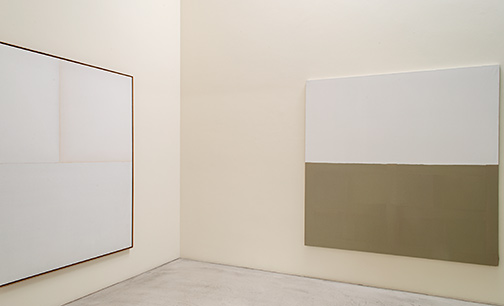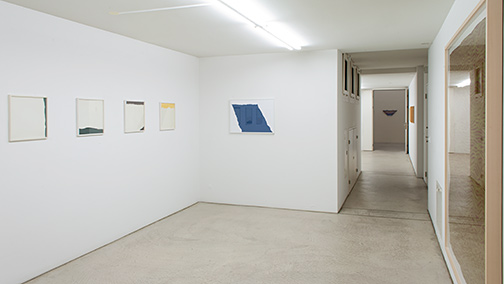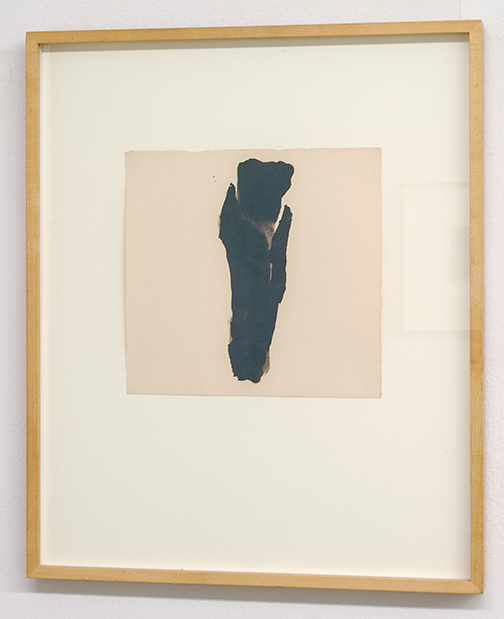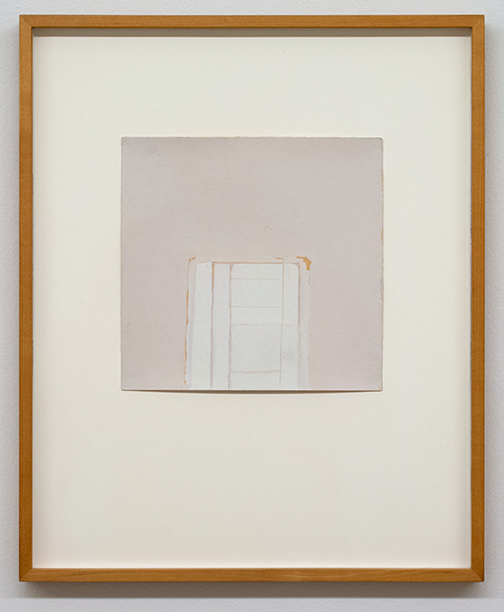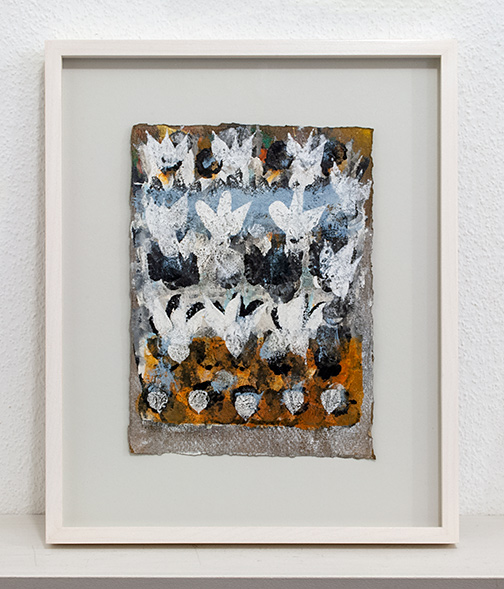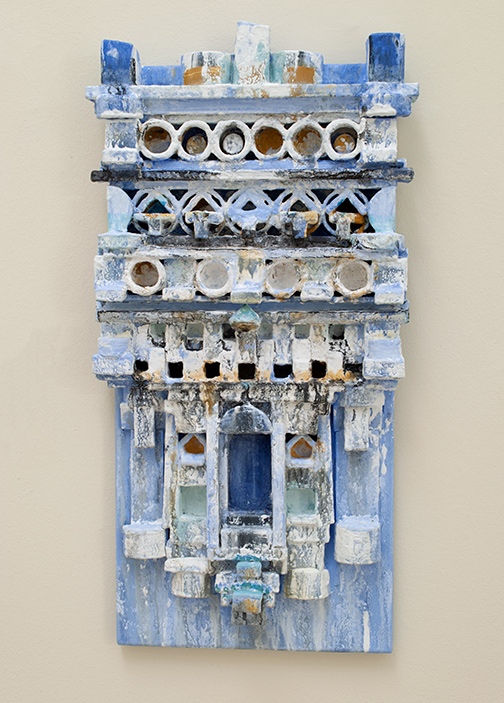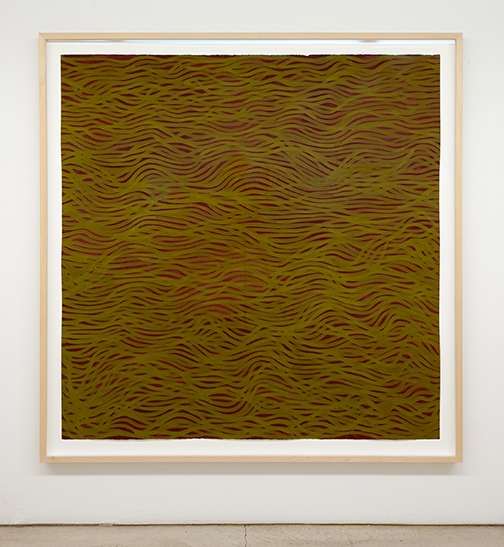An arranged meeting with James Bishop in Blévy in 1975 led to my first encounter. Shortly before, he had moved from Paris to Blévy, and taken up residence in the former presbytery of the small village. The village is not easily accessible. For example, it does not have its own railroad connection.
For the first conversation, the house’s new occupant led me through the large garden surrounded by a wall. The property had no studio where works that had been started or even finished could have been viewed, and the tool shed that had been intended for a studio never ended up getting adapted for this purpose.
A small room with exquisite light on the upper floor of the house contained a modest work table. From then on, this remained James Bishop’s main workplace.
He opened a portfolio containing a number of large-format, mostly white paintings on paper. Stunning works with reference to his large white paintings. My unrestrained enthusiasm was conveyed, without many words. However, there was hardly any time left before the tedious journey back to Paris. What a pity that Annemarie had not been able to accompany me.
But the very next year, in 1976, the first exhibition took place in our gallery. Looking back, James’s ready assent remains a great exception. (As well as the fact that three new paintings were created for this exhibition.)
He made his way to Zurich by train. Under his arm he carried three rolled canvases. The oil paint on the paintings had barely dried. In the gallery he mounted them onto the prepared stretchers. The memorable show of the three white paintings became a considerable success. Thus began our friendship of forty-five years, which was not without its occasional complications.
It took some time for us to understand that having to make decisions was frequently a burdensome task for our friend. It is quite possible that his move to the remote village was itself prompted by a variety of personal circumstances. In any case, the flat expansive landscape gave rise to his daily habit of cycling for hours, a healthy (and sometimes hazardous) passion.
In the last years of his life, his home and garden were a real refuge for James. His increasingly limited mobility no longer permitted even a short trip to Paris. Nevertheless, during our regular telephone conversations, we got the impression that a relaxed serenity had taken hold in his old age. Again and again, he emphasized how much the house and beautiful garden had become a daily source of joy and happiness. Decisions could be continually postponed at this stage of life until they were no longer demanded or expected by anyone.
He never gave up the small studio on Lispenard Street in New York. We remember well some of our visits in earlier years. More and more, however, his home country represented an unwelcome welcome and his stays in New York grew less and less frequent.
In Paris we often saw each other, and visited museums and exhibitions together. In later years, the trip to Blévy became more frequent.
James’s extensive education was astonishing, encompassing the fields of art, literature and music but also philosophy and history. Acquired over many decades, his knowledge was far-reaching and almost obsessed with detail, and he had an exceptional memory. French and international political events engaged him with intense interest. The reading of multiple daily newspapers was an especially cherished activity.
It was around 1978 or 1979 when we managed to persuade James to spend some days with us in the Münstertal valley of the Grisons region. The initial skepticism immediately turned into a passionate love for the mountains of Switzerland. It became a wonderful mutual understanding that we would spend holidays together in the Swiss Alps every year in late summer. Over the course of the year, our friend studied the corresponding hiking maps as well as the timetables of post buses and train connections. Of course, he was soon the one who determined which paths and destinations would be on our itinerary. His early proposals were sometimes more theoretical and hit-or-miss, but we were eventually able to steadfastly rely on his suggestions and estimates.
Gianfranco Verna
On February 17, 2021, James Bishop’s life came to an end. His life was undoubtedly an artist’s life, although James always found it difficult to prove his artistry with the creation of numerous works. It was the insurmountable difficulty of determining a beginning or an end that always instigated a block. It may also have been his strictly ordered normative concept of artistic meaning and importance that made it so hard to find the right place for the exercise of his craft.
To argue with Bruno Latour, the system of creation seemed more fitting of artistic activity than the system of production, in the artist’s view. More and more, however, the creation of works was then shifted to the process of emergence. This subsequently took up far more time. And the works themselves were actually supposed to articulate when they were valid or completed.
James Bishop’s works are unmistakably linked to his person. Art, and likewise his own conduct, found a unified core in his personality, a circumstance determining his way of life. However, it is inaccurate to see James as a stubborn loner. His life’s work has both a synchronic and a diachronic pole.
As for many other young artists, the powerful impression of the paintings by that important generation of post-war American painters – Pollock, de Kooning, Gorky and Kline, as well as Rothko, Newman, Reinhardt, Still and Motherwell – was an important starting point for his own artistic aspirations.
The new immediacy with which excitation and emotion manifested themselves on the surfaces of the large formats by these older contemporaries opened up possibilities and points of connection for a younger generation. The fascination and seductive power were overwhelming, but to create something of one’s own required an equal measure of distance and in many respects had to be painted in opposition to these overpowering role models and their influence.
For Bishop, his knowledge of the history and rich tradition of European painting remained a weighty reference from the outset. In 1957 he made his first trip to and through Europe, and from 1958 he lived in Paris for many years without interruption. Paul Cezanne, Pierre Bonnard, Edouard Vuillard, Henri Matisse, Bram van Velde now offered an additional source of stimulating ideas and set a further standard for his own artistic activity.
In 1962, his art historical interests and inclinations prompted him to travel to Italy for several months. The history of light and color, Piero della Francesca, Giovanni Bellini, Lorenzo Lotto and the Venetians of the 16th century could thus be experienced first-hand. Bishop was equally interested in the material and the painting process. They enabled him to understand that painting has to do with touch and with surfaces. The act of the painter is the gesture, both spontaneous and reflected, which encompasses the artist’s own intention and the perception of what is created, while the aesthetic object is the realization and the visible or hidden presence of the complex painting process.
It is to the eminent credit of the painter James Bishop that, especially in the canvases created between 1967 and 1986, mostly 185 x 185 cm up to 195 x 195 cm in size, the surface of the painting becomes the actual pictorial event, as a sensually perceptible entity. The skin formed by the dried oil paint has a presence that, if the corporeal analogy is to be taken further, gives the painting the appearance of a pictorial body. The density and quality of this paint skin, built up from the application of multiple layers and different tones, becomes especially visible and tangible when the white primed canvas remains partially unpainted. The result is a color fringe brimming with subtle vibration.
The internal organization and partition of the painting by means of bars and the resulting subdivided surfaces is integrated into the paint skin, as it were. It defines the respective work, giving weight to the top and bottom, while the left and right sides of the painting are both singly indicated and mutually interlinked. But these are not hints of representational signifiers of meaning. Any narrative in the sense of the figure/ground scheme is precluded. The fact that the unmediated encounter of the viewer with the body of the painting thus becomes part of the reception process plays a decisive role in the aesthetic experience. When presenting the works, it is therefore critical that they be hung only around thirty to forty centimeters from the floor. The reference to the floor thus creates a connection with the viewer as they approach the painting.
After the year 1986, no further wholly successful large-format canvases were created, without this momentous break being due to any explicit decision. James Bishop’s paintings on paper, mostly no larger than 25 x 25 cm, now provided the adequate form to continue his artistic work in a valid and diverse way. (A good overview can be found in the book “James Bishop – Malerei auf Papier Paintings on Paper” published in 2018 by Sieveking Verlag, Munich.)
By the end of the artist’s life, a body of work of incomparable delicacy and subtlety had emerged. The small pieces of paper, most of which James took in their original format and texture, each provided different surfaces and materialities, with hues and physical qualities that lent themselves as a point of entry and inspiration. The form demonstrates a kinship to early and earlier works, with the formal structure of the paintings now becoming diverse and highly differentiated.
The majority of the fine shading is executed in sandy gray tones. But there are also paintings in other colors, blue, yellow, brown. Drawn interventions in chalk, colored pencil or pencil take on a sensitive and stabilizing presence.
James was always very keen on dividing works into small groups with which the individual sheets could complement, even explain, one other. This was to be heeded whenever four or five of the paintings were allowed to leave Blévy for the first time to be exhibited, which unfortunately happened all too rarely.
James Bishop never put personal thoughts on his own work in writing. The extensive conversation with Dieter Schwarz, which was printed in the catalog of the first retrospective in 1993/1994 (edited by Dieter Schwarz and Alfred Pacquement), is an authentic and reliable account that is often referenced and rightly so.
Gianfranco Verna





